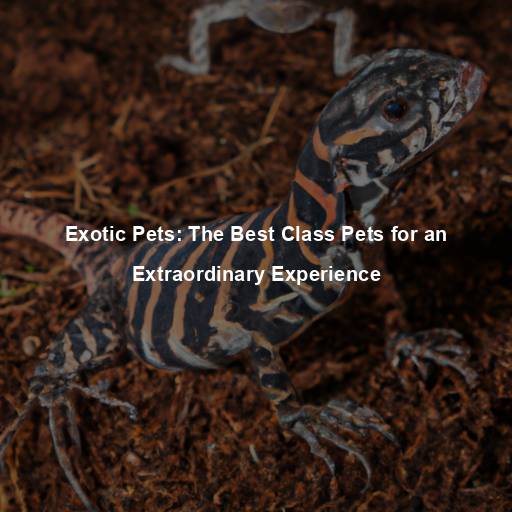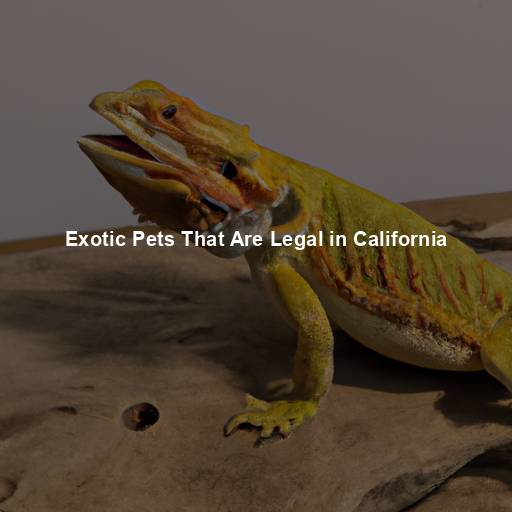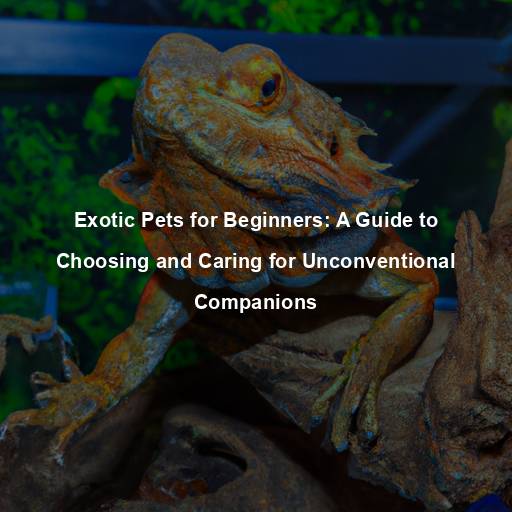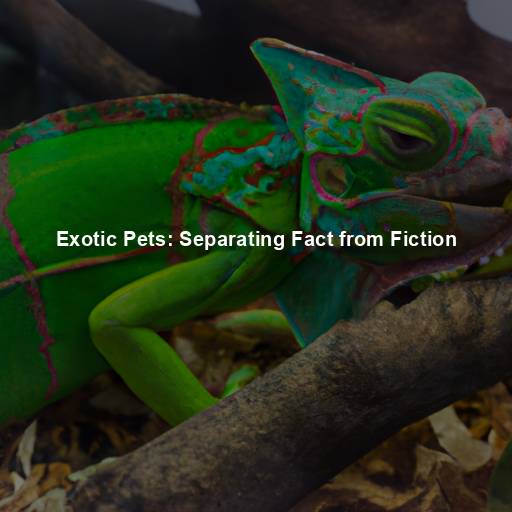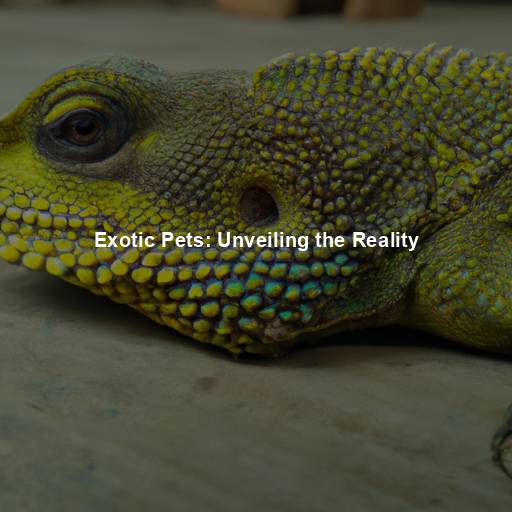Exotic Pets: The Best Class Pets for an Extraordinary Experience
Last Updated on October 31, 2023 by Evan
Contents
- 1 Exotic Pets: Unleashing the Fascination
- 2 Choosing the Perfect Class Pet
- 3 The Educational Value of Exotic Pets
- 4 Responsible Pet Ownership: A Shared Responsibility
- 5 Embrace the Extraordinary
- 6 Addressing Concerns and Misconceptions
- 7 Building a Supportive Community
- 8 FAQs for Exotic Pets as the Best Class Pets
- 8.1 What are exotic pets?
- 8.2 Why are exotic pets considered as the best class pets?
- 8.3 What are some examples of popular exotic pets for classrooms?
- 8.4 Are exotic pets suitable for all classrooms?
- 8.5 What responsibilities come with having exotic pets in the classroom?
- 8.6 Will having an exotic pet be a distraction in the classroom?
- 8.7 What precautions should be taken when handling exotic pets in the classroom?
- 8.8 Are there any legal restrictions or permits required for keeping exotic pets in the classroom?
- 8.9 How can the presence of exotic pets benefit students?
- 8.10 What alternatives are there for classrooms that cannot have exotic pets?
Exotic Pets: Unleashing the Fascination
Exotic pets have long intrigued humans with their unique beauty, extraordinary behaviors, and captivating allure. From the mesmerizing scales of a bearded dragon to the playful antics of a sugar glider, these creatures offer a refreshing alternative to more traditional pets. As we embark on a journey to explore the world of exotic pets, we uncover the best class pets that can bring joy, wonder, and a touch of the extraordinary to our lives.
The Appeal of Exotic Pets
There is something undeniably enchanting about exotic pets that sets them apart from their more conventional counterparts. With their vibrant colors, graceful movements, and captivating personalities, these creatures bring a sense of adventure and intrigue into our lives. Whether it’s the rhythmic slither of a snake, the graceful flight of a bird, or the vibrant hues of tropical fish, these animals transport us to a world that is both mesmerizing and perplexing. There is a mystique to owning an exotic pet that ignites our imagination and leaves us yearning for more.
The Unique Bond with Exotic Pets
There’s something truly extraordinary about the bond we forge with our pets, but when it comes to exotic companions, the connection takes on a whole new level of awe-inspiring depth. It’s as if we’re delving into uncharted territory, needing to navigate a complex web of understanding, nurturing, and reverence to ensure the happiness and health of these extraordinary creatures. This one-of-a-kind relationship becomes a catalyst for personal growth, expanding our capacity for compassion, and instilling a sense of duty that blossoms into an unforeseen path to self-discovery. It’s an adventure that perplexes, yet rewards us with a richness of experience that words cannot do justice.
Choosing the Perfect Class Pet
Finding the perfect exotic pet to accompany your classroom journey may seem like a mind-boggling expedition, tinged with both excitement and puzzlement. A myriad of considerations loom on the horizon, stretching from the pet’s dainty dimensions to the intricate demands of its care. Fear not, as we have sought to unravel this enigmatic conundrum, heralding a compilation of unrivaled class companions that promise to illuminate your educational domain with a touch of delight and enlightenment.
Bearded Dragons: Captivating Companions
Bearded dragons are among the most popular exotic pets for classrooms due to their docile nature and relative ease of care. These magnificent reptiles are known for their unique appearance, with spiky scales and a “beard” under their chin. With proper handling and care, bearded dragons can become docile companions that students can observe and interact with, fostering a deeper understanding of reptiles and their habitats.
Madagascar Hissing Cockroaches: Creepy Crawlies with a Purpose
Prepare to delve into the captivating world of the Madagascar hissing cockroaches, a peculiar species that despite its initial shiver-inducing reputation, presents an intriguing educational opportunity. Discover the remarkable ease of caring for these large insects, while simultaneously gaining an up-close perspective into the enigmatic realm of invertebrates. Engage in a sensory experience as students bear witness to their peculiar behaviors, explore the intricacies of their life cycle, and actively participate in hands-on activities, including constructing habitats and conducting experiments. Prepare for a journey that defies preconceptions and beckons you to embrace the perplexing allure of these fascinating creatures.
African Dwarf Frogs: Aquatic Ambassadors
If you’re searching for an aquatic companion to bring into your classroom, look no further than the captivating African dwarf frogs. These petite amphibians boast an impressive adaptability, making them a breeze to care for in compact tanks. By immersing themselves in the study of these fascinating creatures, students are bound to unravel the enigmatic intricacies of amphibian life. Furthermore, nurturing and tending to these endearing beings not only imparts a lesson in responsibility but also fosters a deep-rooted empathy for the diverse underwater realm.
Crested Geckos: Arboreal Wonders
Step into the enchanting world of crested geckos – mesmerizing beings that have captured the hearts of reptile enthusiasts far and wide. These arboreal marvels possess an inexplicable knack for scaling heights and possess an extraordinary talent for regrowing their tails, adding an intriguing layer of mystique to their already captivating nature. With their visually arresting features and surprisingly undemanding care regime, crested geckos bestow a remarkable chance upon inquisitive students to explore the captivating realm of reptile adaptations, unravel the secrets of their natural habitats, and embrace the essence of responsible pet guardianship. Prepare to be enthralled by these beguiling creatures and embark on an odyssey of discovery like no other.
Hermit Crabs: Tiny Explorers
Step into the mesmerizing world of hermit crabs, tiny creatures with huge personalities. These pint-sized crustaceans possess an untamed sense of curiosity, making them ideal companions for classrooms seeking excitement. Marvel at their peculiar habit of shuffling between shells as they embark on their life cycle, a captivating display of adaptation. Through careful observation and the creation of a nurturing environment, students are transported into the realm of animal behavior, gaining profound insights into our natural world and igniting a passion for environmental conservation.
The Educational Value of Exotic Pets
Introducing exotic classroom pets into the educational landscape is like unearthing hidden treasures, opening the doors to a captivating world beyond the monotonous textbooks. These extraordinary creatures inject a breath of excitement and wonder into the curriculum, propelling students into immersive learning experiences that awaken their senses. From observing the intricate patterns on a chameleon’s skin to witnessing the agile movements of a tree frog, the educational benefits of these exotic pets are as diverse as the ecosystems they hail from.
Science Education
The fascinating world of exotic pets offers a remarkable opportunity for students to delve into the intricate realm of science education. Through the close observation and nurturing of these unique creatures, young minds can unravel the secrets of biology, anatomy, life cycles, and environmental adaptations. The hands-on experience garnered from tending to an exotic pet not only cultivates a profound comprehension of scientific concepts but also ignites the sparks of critical thinking, fostering a sense of wonder and curiosity in young minds. In this captivating journey, the unexpected twists and turns of discovery await, inviting students to embrace the perplexing beauty of the natural world.
Responsibility and Empathy
Owning an exotic pet demands an undeniable sense of commitment and understanding. Educators have found a remarkable strategy to cultivate essential virtues like compassion, respect, and responsibility in students by assigning them specific tasks relating to the wellbeing of the class’s unconventional friend. This unique approach exposes students to the significance of fulfilling the needs of another living creature, evolving their empathetic capabilities beyond the four walls of the classroom. As their paths intertwine with their furry or scaly companions, students embark on a perplexing journey that awakens a deeper understanding of empathy.
Environmental Awareness
Exotic pets offer a unique opportunity to raise awareness about the natural habitats from which they originate. Educators can incorporate discussions about conservation, habitat preservation, and the impact of human activities on biodiversity. By understanding the ecological needs of their class pet, students develop a sense of environmental responsibility and are encouraged to make informed choices that promote conservation.
Emotional Well-being
Having an unusual creature as a part of the classroom dynamic can surprisingly ignite a plethora of positive emotions within students. Studies have proven that engaging with animals has the remarkable ability to alleviate stress, enhance one’s overall mood, and foster social connections. The mere presence of a class pet can effortlessly cultivate an atmosphere of nurturing care, where students are able to thrive in their educational journey, feeling secure, encouraged, and actively involved.
Development of Life Skills
Taking care of an exotic pet is no ordinary task. It demands a whirlwind of skills that extend far beyond textbooks and classrooms. From the intricate art of organization to the adrenaline-fueled juggling act of time management, students delve into a perplexing world of problem-solving and collaboration. Through the creation of intricate habitats and meticulous attention to cleanliness, they unlock the secrets of responsibility and the boundless potential hidden within.
While exotic pets can offer a unique and enriching experience, it is essential to approach their ownership with responsibility and respect. Educators, students, and parents must work together to ensure the well-being and welfare of these extraordinary creatures. Here are some key considerations for responsible pet ownership:
Research and Education
Before bringing an exotic pet into the classroom, thorough research is necessary. Educators should familiarize themselves with the specific care requirements, lifespan, and potential challenges associated with the chosen pet. Additionally, students should be educated about the pet’s natural habitat, behavior, and appropriate handling techniques.
Enclosure and Environmental Enrichment
Ensuring the utmost comfort and happiness of our beloved pets is a responsibility we hold dear. Creating a living space that fully captures their natural instincts and desires is key to nurturing their overall well-being. From mimicking their natural habitat to offering a wealth of opportunities for exploration and movement, a carefully curated enclosure is paramount. To ignite their curious spirits, we must also engage their minds with stimulating substrates, exciting climbing structures, and playful toys.
Veterinary Care
Regular veterinary check-ups are crucial for the health and well-being of any pet, including exotic ones. Educators should establish a partnership with a knowledgeable exotic animal veterinarian who can provide guidance on proper nutrition, preventive care, and any specific health concerns related to the chosen pet.
Ethical Considerations
When choosing an exotic pet, it is important to consider ethical factors such as the source of the animal. Pets should be acquired from reputable breeders or rescue organizations that prioritize the welfare of the animals. It is crucial to avoid supporting illegal wildlife trade or practices that harm endangered species or their habitats.
Education and Safety Precautions
In the world of education, a crucial responsibility lies in nurturing young minds to develop understanding and respect for all living creatures. When it comes to class pets, it falls upon educators to impart upon students the knowledge and wisdom surrounding safe handling practices and appropriate interactions. As young learners navigate the realms of curiosity and boundlessness, they must also be made aware of potential risks, as well as the crucial importance of respecting the boundaries of these cherished animal companions. By providing consistent supervision and establishing clear guidelines, both the well-being of the students and the pet can thrive harmoniously within the classroom environment.
Embrace the Extraordinary
Discover the untamed allure of exotic pets and unlock a gateway to a world of extraordinary educational opportunities. With a careful selection process, these captivating creatures can dive headfirst into our curriculum, infusing our classrooms with a sense of wonder and curiosity. Embrace the enigmatic nature of life as we embark on a journey filled with intrigue, empathy, and a profound appreciation for the diverse wonders of the animal kingdom. Let us boldly step into the realms of experiential learning, where the extraordinary becomes the norm.
Bringing exotic pets into the classroom opens the door to a world of extraordinary educational possibilities. Students are captivated by the chance to dive headfirst into hands-on learning, immersing themselves in the subject matter like never before. Through direct observation, interaction, and nurturing, these remarkable creatures become more than just a lesson in textbooks – they become catalysts for a voyage of profound understanding and astonishment.
Encouraging Observation and Inquiry
Having an unusual critter in the classroom can ignite a spark in the minds of students, fostering an unwavering curiosity about the wonders of the natural world. By delving into the intricacies of the pet’s behavior, movements, and social interactions, students embark on a perplexing journey that compels them to ask thought-provoking questions and unravel the mysteries that lie beneath the surface. This tantalizing process of inquiry not only nourishes their hunger for knowledge but also hones their critical thinking abilities, allowing them to dissect and comprehend the underlying motives behind their unique pet’s every action.
Hands-On Learning Opportunities
Exploring the intriguing world of exotic pets unlocks a myriad of captivating adventures that ignite young minds with an undeniable fascination. By immersing themselves in the feeding intricacies, maintaining pristine habitats, and even conducting scientific investigations, students unveil a perplexing realm of discovery. Engaging in these enthralling activities cultivates an intimate bond with the subject matter, transforming their educational journey into an enchanting expedition like no other.
Integration Across Disciplines
Having an exotic pet in the classroom can truly transform the learning experience into a mesmerizing journey that intertwines different disciplines effortlessly. From unraveling the intricate biology of the pet to exploring its geographical origins, students have the chance to dive headfirst into an educational whirlpool of curiosity and discovery. They can let their creativity soar by creating vivid artwork inspired by the pet’s captivating colors and patterns, while also delving into the fascinating realm of mathematics by calculating the pet’s growth rate. Additionally, the pet’s presence can ignite a spark of literary brilliance as students weave enchanting stories and poignant poems inspired by their heartfelt interactions with their newfound companion.
Addressing Concerns and Misconceptions
Despite the many benefits of having an exotic pet in the classroom, concerns and misconceptions may arise. It is important to address these concerns proactively to ensure a safe and educational environment for both the students and the pet.
Health and Safety Considerations
One common concern is the potential health and safety risks associated with exotic pets. Educators must establish clear guidelines for handling the pet, emphasizing proper hygiene practices and safety precautions. Students should be educated about potential allergens, zoonotic diseases, and the importance of washing hands after handling the pet or its habitat.
Allergies and Sensitivities
Some students may have allergies or sensitivities to certain animals. It is crucial to identify any potential allergies or sensitivities before introducing an exotic pet into the classroom. Sensitivities can vary from fur or feathers to specific proteins found in the pet’s dander or saliva. If any student exhibits allergies or sensitivities, alternative arrangements should be made to ensure their safety and well-being.
Ethical Considerations and Animal Welfare
One cannot overlook the ethical quandary surrounding the captivating allure of exotic pets. It is incumbent upon educators to instill a sense of responsibility in pet ownership, holding paramount the welfare of these extraordinary creatures. By imparting knowledge about the unique needs and requirements these animals possess, students can truly grasp the importance of preserving their physical and psychological well-being. Ultimately, stimulating conversations about animal welfare and conservation can nurture a profound sense of empathy in the hearts of young minds, propelling them towards responsible stewardship of these enigmatic beings.
Potential Disruption to the Learning Environment
It’s natural for concerns to arise when it comes to having an exotic pet in the classroom. People might wonder whether it would disrupt the learning environment or cause distractions. However, educators have the power to turn this situation into an educational opportunity by establishing clear routines and expectations for the care and handling of the pet. By emphasizing that the well-being of the pet is a shared responsibility, students can grasp the importance of minimizing disruptions through proper planning and supervision.
Building a Supportive Community
Creating a supportive community around the presence of an exotic pet in the classroom is essential for its success. This community includes educators, students, parents, and even external experts who can provide guidance and support throughout the journey.
Engaging Parents and Guardians
Educators should actively involve parents and guardians in the process of introducing an exotic pet into the classroom. Providing information about the chosen pet, its care requirements, and the educational benefits can help alleviate any concerns and encourage parental support. Parents can also contribute by sharing their knowledge or experiences related to the pet or by volunteering to assist with its care.
Collaboration with Experts
Collaborating with experts in the field of exotic pet care can provide valuable insights and guidance. Local veterinarians, herpetologists, or experienced exotic pet owners can offer advice on proper care, habitat setup, and potential educational activities. Their expertise can enhance the learning experience and ensure the well-being of the class pet.
Sharing the Journey
Sharing the journey of having an exotic pet in the classroom with the wider school community can foster a sense of excitement and engagement. Regular updates, newsletters, or presentations can showcase the pet’s progress, highlight educational activities, and involve other classes or grade levels in related projects. By involving the entire school community, the benefits and educational value of the class pet can be maximized.
FAQs for Exotic Pets as the Best Class Pets
What are exotic pets?
Step into the world of unconventional companions! Exotic pets bring a touch of enigma to the realm of pet ownership, introducing a tapestry of extraordinary species seldom associated with domesticity. From slithering reptiles and vibrant amphibians to feathered wonders and miniature mammals, these unconventional creatures will bewilder and fascinate you. Imagine the thrill of owning an invertebrate marvel like a tarantula or a scorpion, cultivating an extraordinary bond bound to leave everyone in awe.
Why are exotic pets considered as the best class pets?
Adding an unconventional touch to the classroom, exotic pets stir up a captivating whirlwind of intrigue and bewilderment. With their mystifying presence, these extraordinary creatures mesmerize students, igniting a flame of curiosity that smolders with every encounter. In the realm of education, these enigmatic companions serve as extraordinary emissaries of knowledge, enlightening young minds about the intricate components of biology, ecology, and the tantalizing world of animal behavior. Embracing these unique classroom citizens also nurtures values of responsibility and empathy as students develop an intimate connection with them, diligently tending to their needs and gaining a profound appreciation for the wonders of the animal kingdom.
What are some examples of popular exotic pets for classrooms?
When it comes to selecting an exotic pet for the classroom, the options are as diverse as one’s imagination. From the enchanting reptiles like bearded dragons and geckos, to the mesmerizing corn snakes, the choices are nothing short of perplexing. For those seeking the company of furry friends, small mammals like guinea pigs, hedgehogs, or hamsters are popular contenders. And let’s not forget about our feathered friends, with their vibrant plumage and captivating chirps – parakeets and cockatiels can truly elevate the classroom experience. However, before embarking on this wild journey, it is imperative to delve into thorough research, understanding the unique needs and requirements of each species, ensuring that a nurturing and suitable environment can be provided within the confines of the classroom.
Are exotic pets suitable for all classrooms?
Bringing exotic pets into classrooms is like dancing on a tightrope – thrilling, but with a dizzying blend of challenges and uncertainties. Before tiptoeing into this uncharted territory, teachers must navigate a treacherous maze of considerations. From deciphering the school’s pet policies to uncovering hidden allergies and juggling cramped spaces, these brave educators must conduct a symphony of research, playing the uncertain notes of feasibility and practicality alongside the guidance of experts and seasoned exotic pet owners.
What responsibilities come with having exotic pets in the classroom?
Having an exotic pet in the classroom is no small feat – it demands an abundance of responsibility and care. Teachers and students alike should be equipped with the knowledge and understanding required to provide these unique creatures with the appropriate sustenance, living conditions, and overall care they necessitate. Additionally, it is crucial to establish a consistent and thorough cleaning regimen, as well as create an environment that prioritizes the pet’s safety and serenity. By involving students in the caregiving process, educators can simultaneously educate and empower young minds about the intricate needs of these extraordinary animals, assigning them tasks that align with their age and abilities while ensuring the pet’s well-being.
Will having an exotic pet be a distraction in the classroom?
While exotic pets can grab the attention of students initially, proper planning and integration into the curriculum can help minimize distractions. Teachers can use the presence of these pets as a teaching tool, incorporating lessons about biology, habitats, or responsible pet ownership. Establishing clear expectations and rules regarding interactions with the pet will help maintain a focused learning atmosphere while still allowing students to benefit from the unique experience of having an exotic pet in the classroom.
What precautions should be taken when handling exotic pets in the classroom?
When handling exotic pets, it is vital to follow appropriate safety protocols to ensure the well-being of both the pet and the students. Teachers should educate themselves and the students about proper handling techniques, potential risks, and hygiene practices. Students should always be supervised while interacting with the pet and taught to approach and handle it gently and respectfully. Regular check-ups by a veterinarian experienced with exotic animals are highly recommended to ensure their health and prevent any potential zoonotic diseases.
Are there any legal restrictions or permits required for keeping exotic pets in the classroom?
Keeping exotic pets can be a whirlwind of uncertainty and confusion, with laws and regulations varying from place to place. To avoid getting tangled in a web of legal issues, it’s vital to reach out to local authorities – animal control or the Department of Fish and Wildlife – to unravel the perplexing legality of having exotic pets in a classroom setting. Brace yourself for the possibility of permits or licenses being required, as these bumpy bureaucratic roads may need navigating. When venturing into this wild terrain, it’s crucial to acquire your furry, scaly, or feathery friend from a trustworthy source, one that is committed to ethical practices and captive breeding programs, ensuring a happier and healthier life for these extraordinary creatures.
How can the presence of exotic pets benefit students?
There is something undeniably magnetic about having an exotic pet by your side, especially for students. These peculiar creatures have this astonishing ability to turn learning into an exhilarating adventure, opening doors to new realms of hands-on exploration that textbooks simply cannot replicate. Through caring for these unconventional companions, students inadvertently unlock a gateway to empathy and responsibility, as they navigate the intricate dance of meeting their pet’s needs and wants. In the midst of this dynamic relationship, curiosity blossoms, propelling students to delve deeper into the mysteries of the natural world. Such encounters amplify observation skills, sparking a fire of research-driven inquiry that consumes their every waking moment. And as the bond between student and exotic pet strengthens, a profound connection emerges, one that not only nurtures their social and emotional development but also cultivates a profound respect for the fascinating tapestry of life. Step inside these unconventional classrooms, and you’ll find an entire universe of engagement and wonderment that transcends the boundaries of traditional education paradigms.
What alternatives are there for classrooms that cannot have exotic pets?
In a world where the boundaries of the classroom can sometimes restrict the magic of the animal kingdom, educators find themselves confronted with perplexing challenges. Fear not, for the realm of alternative options unveils itself, offering a burst of innovative and captivating solutions. Embark on a journey through the virtual realm, where exotic creatures come to life through live-streaming and pre-recorded marvels, allowing students to explore their intricate characteristics and mesmerizing behaviors. Venture beyond the confines of the classroom and immerse yourself in the wonders of local zoos, wildlife sanctuaries, and educational centers, where hands-on encounters await, bypassing the need for a permanent classroom companion.

